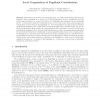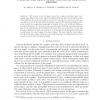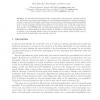WAW
2007
Springer
14 years 8 months ago
2007
Springer
Motivated by the problem of detecting link-spam, we consider the following graph-theoretic primitive: Given a webgraph G, a vertex v in G, and a parameter δ ∈ (0, 1), compute th...
WAW
2007
Springer
14 years 8 months ago
2007
Springer
We present a new stochastic model for complex networks, based on a spatial embedding of the nodes, called the Spatial Preferred Attachment (SPA) model. In the SPA model, nodes have...
WAW
2007
Springer
14 years 8 months ago
2007
Springer
WAW
2007
Springer
14 years 8 months ago
2007
Springer
A random graph model based on Kronecker products of probability matrices has been recently proposed as a generative model for large-scale real-world networks such as the web. This...
WAW
2007
Springer
14 years 8 months ago
2007
Springer
WAW
2007
Springer
14 years 8 months ago
2007
Springer
Inspired by the recent interest in combining geometry with random graph models, we explore in this paper two generalizations of the random dot product graph model proposed by Kraet...
WAW
2007
Springer
14 years 8 months ago
2007
Springer
Abstract. We study the relation between PageRank and other parameters of information networks such as in-degree, out-degree, and the fraction of dangling nodes. We model this relat...
WAW
2007
Springer
14 years 8 months ago
2007
Springer
Social networks are ubiquitous. The discovery of close-knit clusters in these networks is of fundamental and practical interest. Existing clustering criteria are limited in that cl...
WAW
2007
Springer
14 years 8 months ago
2007
Springer
Popular reputation systems for linked networks can be manipulated by spammers who strategically place links. The reputation of node v is interpreted as the world’s opinion of v�...
WAW
2007
Springer
14 years 8 months ago
2007
Springer
Abstract. This paper describes a technique for reducing the querytime cost of HITS-like ranking algorithm. The basic idea is to compute for each node in the web graph a summary of ...



